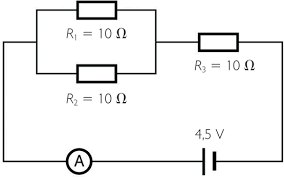UNIT6. ENERGY AND ELECTRICITY.
KEY WORD:
BOOK UNIT Nº8: "ENERGY": * Describing motion and how it works.
The effects of this electric current are:
a) HEAT: The movement of electrons ina a cable causes continous collisions and an increase in the temperature of the cable. The heat energy generated by an electric current is called the Joule Effect: E= I^2 * R * t.
b) LIGHT: Through incandescence, or through phosphorescent material.
c) MOTION. Through magnetic fields that produces forces into the wires: dynamos, alternators, motor.
There are three types of materials:
a) Conductor: allow electricl currents to pass through them (all metals are conductor).
b) Insulator: don´t allow electric currents to pass throwgh them: wood, glass, plastic.
c) Semiconductor: have properties which are intermediate in magnitude between conductors and insulators: silicon and germanium.

b) IN PARALL: when the voltage across each componet is the same, but the current that floww through each branch is different.


VIDEO ACTIVITY: ELECTRICITY
BOOK UNIT Nº8: "ENERGY": * Describing motion and how it works.
INDEX:
1.- ENERGY
2.- ELECTRICITY. "OHMS´S LAW": Current(Ampers)=Voltage(Volts) / Resistance(Ohmios)
2.- ELECTRICAL CIRCUITS: a) Serial RT=R1+R2+R3... b) Parallel RT=1/(1/R1+1/R2+1/R3...)
1.- ENERGY.
For millennia, muscle energy was the main source of energy that human beings used. But humans have, over time, invented different mechanisms and machines that have reduced the effort needed to perform work processes and have improved our quality of life. This machines need energy to function.
Energy is the capacity of an object or body to transforms an energy source into work.
Energy is transformed into work and the units of work are a measumement of the energy used (JOULES acording to the International System).
POWER:
We often calculate the capacity of an object to realease energy quickly (work done per unit of time). P=W/t, Power is measure in Watts, and Work in Joules.
TYPES OF ENERGY:
- MECHANICAL: Kinetic and Potencial.
- ELECTRICAL.
- ELECTROMAGNETIC.
- SOUND.
- CHEMICAL
- NUCLEAR
- THERMAL.
2.- ELECTRICITY.
Electric Current is a continuous movement of electrons through conductor materials. (They flow/move continously like water in a river).
An electric circuit is a set of connected components through which an electric current circulates: a Generator, a Wire Conductor, a Switch and a Receptor.
When the switch is on then through the wire flow electrons acording to this ecuation called LAW OF OHM:
When the switch is on then through the wire flow electrons acording to this ecuation called LAW OF OHM:
Current (Ampers) = Voltage / Resistance
I=V/R
The effects of this electric current are:
a) HEAT: The movement of electrons ina a cable causes continous collisions and an increase in the temperature of the cable. The heat energy generated by an electric current is called the Joule Effect: E= I^2 * R * t.
b) LIGHT: Through incandescence, or through phosphorescent material.
c) MOTION. Through magnetic fields that produces forces into the wires: dynamos, alternators, motor.
There are three types of materials:
a) Conductor: allow electricl currents to pass through them (all metals are conductor).
b) Insulator: don´t allow electric currents to pass throwgh them: wood, glass, plastic.
c) Semiconductor: have properties which are intermediate in magnitude between conductors and insulators: silicon and germanium.
3.- TYPES OF CIRCUITS:
a) IN SERIES: when the current that flows throgh all the components is idential, and the total voltage is the sum of the voltages across each element. 
R_equivalent= R1+R2+R3+...=260+330=590 Ohms
I = V / R_equivalent ; I = 230 / 590 = 0.4 Ampers
b) IN PARALL: when the voltage across each componet is the same, but the current that floww through each branch is different.
R_equivalent= 1 / [(1/R1)+(1/R2)+(1/R3)+...]= 1 / [(1/15) + (1/10) ] = 6 Ohms
I = V / R_equivalent = 60 / 6 = 10 Ampers
c) MIXED: Maintain the current that flows through the components in series, and the voltage across the components in parallel.
R_equivalenttotal= 1 / [(1/R1)+(1/R2)+(1/R3)+...] = 1/[(1/10)+(1/10)] + 10 = 5+10=
= 15 Ohms
I = V / R_equivalent = 4.5 / 15 = 0.3 Ampers
VIDEO ACTIVITY: ELECTRICITY
Are these sentencesTrue or False?
1. Electrons always have a negative charge.
2. Voltage is the force that moves the electrons.
3. The wire does not get hot because the light bulb reduces the current which flows in that circuit.
4. Current is the path between the negative and positive poles.
5. 1,5 V is enough to give you a shock.
6. A current of 1 Amp means that 6.240.000.000.000.000.000 electrons are flowing through the circuit each second.
VIDEO ACTIVITY: "ELECTRIC FENCE"
Fill in the blanks with the appropriate words after you watch the video.
- The first brainiac gets a ………because he completes the …. between the fence and the ground.
- The …………can´t pass …… the brainiac´s body because it can´t go through the polystyrene tiles to the ……. to complete the ………….
- Every time the unit flashes the brainiac´s ……… shouldn´t be touching the ………
- Shocking a lot of …………….. is better than ………………. just one brainiac.
- When the group of brainiacs are …………hands but the last one is not ………on the polystyrene tiles they all get a …………because the last brainiac is not ………….
A.- ACTIVITIES:
1.-What are the units of voltage, current and resistance? |
2.- What devices are used to measure the size of a current and potential difference?
|
3.- What device can be used to control the size of the current in a simple circuit?
|
4.- When a p.d. of 10 V is applied across a resistor, 2 A flows. What is the resistance?
|
| 5.-If a battery is rated at 5 amp-hours, for how long will it be able to provide a current of 0.5 amperes? |
6.- Draw (cocodrille) and calculate the current of the folloween circuits:
- a) Serial: R1=10; R2= 4; R3=6; V=20
- b) Parallel: R1=10; R2= 4; R3=6; V=20
- c) Mixed: R1=10; R2= 4; R3=6; V=20
TASK:
1.- VIDEO ACTIVITY:









